Veneers Frisco
Your Smile Reborn

Hiding smile imperfections no longer has to be impossible thanks to Dr. Gadhiya and our team at Highland Oak Dental. With customized veneers, we can conceal chips, cracks, stains, and gaps to reveal a more uniform and beautiful appearance. This transformational cosmetic treatment can give you the confidence you need to seek new opportunities, so call us today to schedule a consultation to find out how you can get started.
Why Choose Highland Oak Dental for Veneers?
- Comfortable, State-of-the-Art Dental Facility
- Dentist With More Than a Decade of Experience
- Patient-Centered Approach to Ensure Successful Results
What is a Veneer?

Veneers are small shells or laminates that are placed on the affected enamel – usually on the front surface of the teeth. They are wafer-thin – their thickness is about half a millimeter – and can either be made from porcelain or resin composites. Although a small portion of enamel must be removed for placement, they can last 10-15 years before needing to be replaced.
Types of Veneers

There are multiple types of veneers that might be recommended depending on several factors, including speed of treatment, budget, and patient preference. They include:
Porcelain Veneers
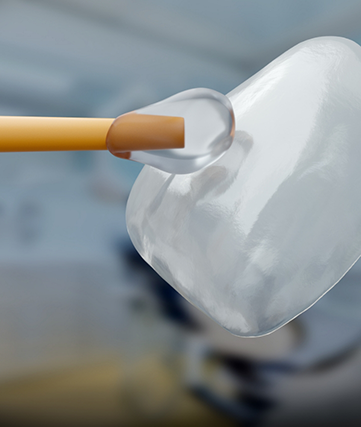
Porcelain veneers are most similar to natural teeth in terms of their appearance – a factor that makes them most popular among patients. They can change the size, shape, and color of the affected teeth. Not only do they have excellent aesthetic benefits, but they’re also durable.
Moreover, they are biocompatible and hardly affect the gum tissues as well as the surrounding ones in the mouth.
Composite Veneers
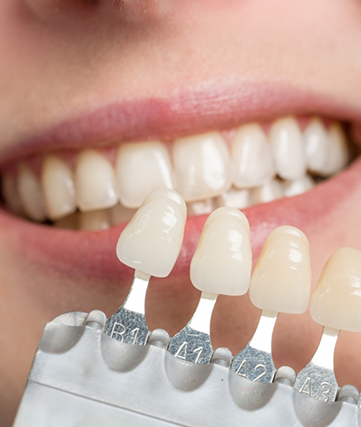
Created from composite resin material (a combination of organic and inorganic substances), composite veneers consist of the filler (an inorganic material utilized in composite resin), while the bonding agent used to create composite resin is just like tooth-colored fillings. They are sturdy but not as durable as porcelain veneers. Thus, they don’t last as long (only for about 5-7 years). Furthermore, compared to porcelain veneers, composites do not match well with the color of natural teeth, and they are most likely to be discolored; however, they are more affordable.
The Veneers Process
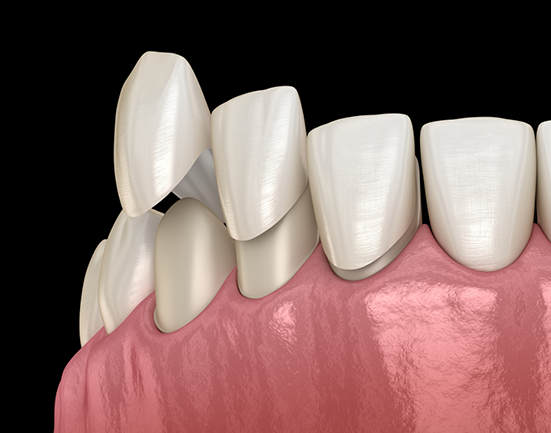
Unlike direct bonding, applying the sheaths can be a little complicated. The entire procedure involves a 3-step process:
- Consultation and planning phase
- Preparation of the mouth and creation of impressions
- Actual installation
Usually, it takes about two to three visits to finish the whole process. However, this depends on whether there was a separate consultation. Let’s delve in further.
Consultation & Planning

During this phase, the dentist will explain everything about the case – the dental issue, the solution, and the various options available to the patient as well as the estimated costs they may incur. Our dentist will examine the mouth and determine whether veneers will be the perfect solution for their problem. However, if there is a bite issue, this should be addressed first before proceeding with the application.
Preparing the Patient’s Mouth
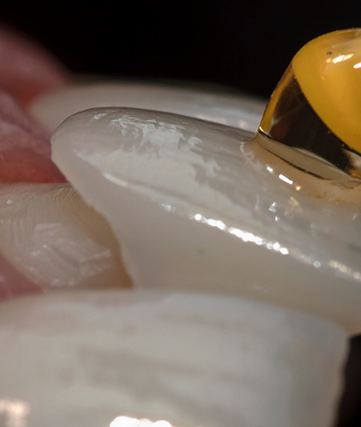
In this step, a thin layer of enamel that is equal to the thickness of the proposed veneers will be removed from the front area of the affected teeth. If they are crooked or crowded, more enamel must be trimmed off. Keep in mind that this process may bruise the gums, resulting in slight discomfort that can last for a few days or until the gums have fully recovered.
Creating Impressions

Once the dentist finishes all the preparations, Dr. Gadhiya will assemble the materials and take the exact measurements needed to make the impressions. This includes the type of material used, the color, and the size. All these will be sent to the lab for manufacturing. Then, the lab will create the impression according to the dentist’s exact instructions. This process normally takes around 10 days to finish, which will overlap with the healing of the gums. Therefore, once the impressions are crafted, the gums have already recovered, which then makes the impressions easier to fit.
Final Application
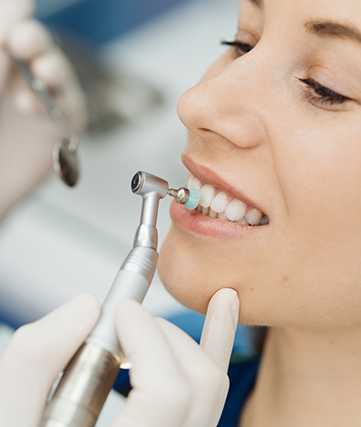
This is the final step. Once the impressions are done, they’ll be sent back to the clinic. Then our experts will have to clean the teeth again by polishing and chemically etching them to roughen their surfaces. They do this so the laminates will bond properly to the teeth. Afterward, the veneers will be attached using transparent cement. Once the installation is a success, the patient will be asked to close their mouth to see if the upper teeth match perfectly with the bottom ones.
Who is a Good Candidate for Veneers?

To know whether you’re qualified to get them, you need to first consult your dentist. They’ll perform a thorough examination before discussing what will happen once you decide to move forward as well as the possible expenses that may occur during the entire process. Nevertheless, they have proven to be useful in the following situations:
- Tooth discoloration
- Worn-out teeth
- Chipped or cracked teeth
- Gaps
- Irregularly shaped or misaligned teeth
Veneer Aftercare

Though the actual installation is not painful, local anesthesia may still be used during the initial preparation of the mouth. Nevertheless, if there is a great deal of pain after the procedure, it’s advisable to go back in so you can get a prescription for over-the-counter medication. Remember, you may have some slight sensitivity that may last for a couple of days. This is because of the trimmed enamel layer. Sometimes, there may be some discomfort while eating hot or cold foods.
But once they are fully installed, aftercare is no longer required. Just remember to brush at least three times a day, floss and rinse, and use mouthwash as instructed. Also, avoid eating hard foods during the first week after the application since they may get cracked or chipped. Keep in mind that broken or chipped veneers are unrepairable.
How Much Do Veneers Cost?

The total price of dental veneers is estimated to be around $250 to $2,500 per tooth. The cost will also depend on the kind of material used. Porcelain veneers generally cost about $925 – $2,500 per tooth, while composite/resin veneers range from $250 and $1,500 for a tooth. Since veneers are considered a cosmetic treatment, most insurance providers do not cover them.
Veneer FAQs
Are veneers permanent?
Veneers are not meant to be lifelong, but they can be expected to last somewhere between 10 and 15 years. They can last even longer with good oral hygiene – their longevity is completely dependent on how well you treat them.
What can't you eat with dental veneers?
For patients with veneers, it is advised to avoid chewing ice, eating sticky or hard candies, consuming hard foods like nuts and pretzels, drinking acidic beverages and alcohol, and minimizing eating or drinking stain-causing foods and drinks.
You can get the most out of them by making sure you treat them well. After all, these are a significant investment in your dental health.
What can go wrong with veneers?
Just like your natural teeth, dental veneers are likely to chip or crack if proper care is not regularly practiced. Furthermore, poor oral hygiene will lead to decay on the sides of the dental veneer, resulting in the corrosion of the tooth under it.








